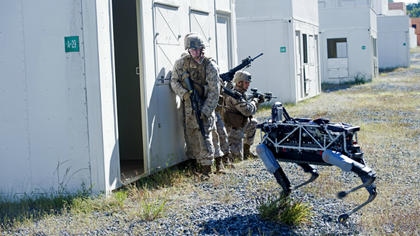-
Tips for becoming a good boxer - November 6, 2020
-
7 expert tips for making your hens night a memorable one - November 6, 2020
-
5 reasons to host your Christmas party on a cruise boat - November 6, 2020
-
What to do when you’re charged with a crime - November 6, 2020
-
Should you get one or multiple dogs? Here’s all you need to know - November 3, 2020
-
A Guide: How to Build Your Very Own Magic Mirror - February 14, 2019
-
Our Top Inspirational Baseball Stars - November 24, 2018
-
Five Tech Tools That Will Help You Turn Your Blog into a Business - November 24, 2018
-
How to Indulge on Vacation without Expanding Your Waist - November 9, 2018
-
5 Strategies for Businesses to Appeal to Today’s Increasingly Mobile-Crazed Customers - November 9, 2018
Meet Spot The Robot Dog
Spot weighs about 70kgs, is electrically operated and walks on four hydraulically-actuated legs. DARPA has tested a number of previous robots from Boston Dynamics, including the BigDog quadruped robot, with the Marine Corps.
Advertisement
The Marine Corps are testing a four-legged Google robot, which can be used for replacing working dogs in the near term.
Indeed, the former gas-burning engines made the robot sound a bit like a chainsaw.
In addition to its robotics technology, Spot includes a small LIDAR (Light Detection And Ranging) laser imaging sensor that’s similar to the sensor installed on the top of Google’s self-driving cars to give them an all-around view of the world.
Employees of DARPA (Defense Advanced Research Projects Agency) were on hand to train marines in how to control Spot. One situation saw Spot sent into to an examine a potentially unsafe building before Marines entered.
In a series of drills that began on September 16, Spot could be seen accompanying soldiers in different conditions and across varying terrain.
Furthermore, Marine Corps Warfighting Lab’s Quantico Brancnh head, Captain James Pineiro notes, “Spot is great and has exceeded the metrics that we’ve provided”. The robo-dog was used as part of an urban terrain drill, among other things. We see it as a great potential for the future dismounted infantry.
The operator can be as far away as 500 meters, and doesn’t need to be within line of sight. “We want to continue to experiment with quadruped technology and find ways that this can be employed to enhance the Marine Corps warfighting capabilties”. The pack mule is capable of carrying up to 400 pounds of gear and follows a handler using computer vision.
Advertisement
The benefits of combat robots are potentially huge, allowing combat operations to be undertaken without risking the loss of human life.




























